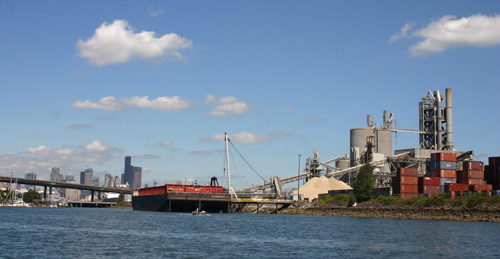By Jessica Partnow
SEATTLE – The Duwamish River is Seattle’s industrial backbone, a source of much of the city’s history, and one of the country’s most contaminated chemical waste sites. Gary Thomsen, a high school history teacher who has devoted much of his career to studying the history of the river, says the now-polluted river valley once boasted “the most fertile soil in the world, second only to the Amazon River.”
But that did not impress the investors and developers who have transformed the landscape of Seattle over the decades. That rich farmland, Mr. Thomsen said, has “been paved over and turned into parking lots and strip malls.”
Decades of heavy manufacturing along the 12-mile-long river, have polluted it and the surrounding underground water with pesticides, heavy metals such as mercury and lead, and chemical solvents. The Duwamish originates as the Green River in the snowy western Cascades and flows north into Seattle’s Elliot Bay.
The Environmental Protection Agency has been working to clean up the river for years. In 2001 it took the dramatic step of designating the Duwamish as a Superfund site, highlighting the river as one of the roughly 1,300 most blighted and polluted locations in the country and negotiating agreements with suspected polluters to pay for restoration. . The federal agency cited the Boeing Company, the City of Seattle, the Port of Seattle and King County as “potentially liable parties.” Without conceding responsibility for the damage to the river, the four agreed to work together with the EPA on the cleanup. Boeing and the others had tried unsuccessfully to head off the stigma of Superfund designation and the formal assignment of financial liability.
No One Loves A Dirty River Long ago, immigrants from Italy and Japan farmed the banks of the Duwamish River. Now a new wave of immigrants has moved in. They are from Mexico and other parts of Latin America. The newcomers have been helping with the clean up. “They don’t want to be exposed to toxins,’’ said B.J. Cummings, the coordinator for the Duwamish River Cleanup Coalition, a non-profit organization designated by the EPA to try to protect the interests of people in the community. - Jessica Partnow
Progress has been painfully slow. One attempt at removing contaminated sediment merely succeeded in further spreading hazardous material. Environmentals say foul substances continue to flow into the river. Scores of storm drains empty into the Duwamish. . Much of the pollution is small-scale, but persistent. In one widely reported instance in May, however, a tractor trailer crashed on a nearby highway and 200 gallons of diesel fuel poured into the Duwamish through a storm drain. By 2007, The Seattle Post-Intelligencer reported that $70 million had been spent on the river project. It foresaw expenditures of as much as $200 million more, adding that environmentalists were saying that, even then, the river would probably remain hazardous.
These days, Seattle’s famous silvery salmon still run in the Duwamish. But warning signs caution, as they have for years, against eating them more than once a month. Other kinds of fish and crabs, State Health Department officials say, are never safe to eat.
At one spot along the river, officials have found concentrations of polychlorinated biphenyls, or PCBs, greater than 900 times the generally accepted safe level. The EPA says PCBs probably cause cancer. High levels of carcinogenic chemicals also have been found in some houses along the river in one of the poorest areas of Seattle.
James Rasmussen, a leader of the Duwamish Native American tribe and a longtime advocate of a healthy river, worries that those working on the clean up do not have their hearts in the job.
“I don’t want to spend hundreds of millions of dollars and not really do something,” he said. “If we are going to really do something, then we need to do it right the first time, so that it gets cleaned and stays clean.”
Mr. Rasmussen says an inconsistent approach to the cleanup may extend the danger beyond the river’s banks. A regional supermarket chain, he said, sells contaminated salmon from the river. They sell “the Green River wild salmon that comes out of this river all over a three state area,” Mr. Rasmussen said, referring to Washington, Oregon and Idaho. “And those fish have problems.”
Funding for this report provided by the KUOW Program Venture Fund, including Puget Sound Energy and Paul and Laurie Ahern. Listen to the five-part radio series Life on the Duwamish.

